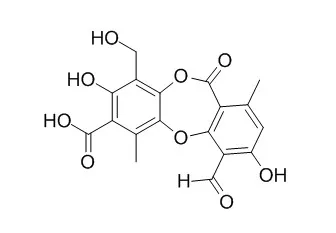| In vitro: |
| Planta Medica, 2008, 74(9):996-996. | | Antimicrobial activity of fumarprotocetraric acid, lecanoric acid, protocetraric acid and stictic acid isolated from different species of lichen.[Reference: WebLink] | The antimicrobial activity of fumarProtocetraric acid, lecanoric acid, Protocetraric acid and stictic acid isolated from the lichens Cladonia furcata (Huds.) Schrad., Ochrolechia androgyna (Hoffm.) Arn., Parmelia caperata (L.) Ach. and Parmelia conspresa (Ach.) Ach. was studied for the following microorganisms: Bacillus mycoides, Bacillus subtilis, Staphylococcus aureus, Enterobacter cloaceae, Escherichia coli, Klebsiella pneumoniae, Aspergillus flavus (ATCC 9170), Aspergillus fumigatus, Botrytis cinerea, Candida albicans, Fusarium oxysporum, Mucor mucedo (ATCC 52568), Paecilomyces variotii (ATCC 22319), Penicillium purpurescens, Penicillium verrucosum, Trichoderma harsianum. Aspergillus flavus, Mucor mucedo and Paecilomyces variotii are ATCC type, and the other microorganisms are clinical isolates.
METHODS AND RESULTS:
The antimicrobal activity was estimated by determining the minimum inhibitory concentration (MIC) by the Broth tube Dilution method. The tested lichen components ihibited growth of all the tested microrganisms. The bacteria showed a bigger sensitivity relative to fungi. The lowest MIC value (0.031mg/mL) was measured for the fumarProtocetraric acid related to the Klebsiella pneumoniae species. The weakest antimicrobial activity was found in stictic acid, which inhibited most of the tested microorganisms in significantly higher concentrations.
CONCLUSIONS:
Generally, all the components had relatively strong antimicrobial activity against the tested microorganisms.
| | Phytomedicine, 2012, 19(13):1166-1172. | | Chemical composition of three Parmelia lichens and antioxidant, antimicrobial and cytotoxic activities of some their major metabolites.[Reference: WebLink] | The aim of this study is to investigate chemical composition of acetone extracts of the lichens Parmelia caperata, P. saxatilis and P. sulcata and antioxidant, antimicrobial and anticancer activities of some their major metabolites.
METHODS AND RESULTS:
The phytochemical analysis of acetone extracts of three Parmelia lichens were determined by HPLC-UV method. The predominant phenolic compounds in these extracts were Protocetraric acid and usnic acid (P. caperata) and depsidone salazinic acid (other two species). Besides these compounds, atranorin and chloroatranorin, were also detected in some of these extracts. Antioxidant activity of their isolated metabolites was evaluated by free radical scavenging, superoxide anion radical scavenging and reducing power. As a result of the study salazinic acid had stronger antioxidant activity than Protocetraric acid. The antimicrobial activity was estimated by determination of the minimal inhibitory concentration by the broth microdilution method. Both compounds were highly active with minimum inhibitory concentration values ranging from 0.015 to 1 mg/ml. Anticancer activity was tested against FemX (human melanoma) and LS174 (human colon carcinoma) cell lines using MTT method. Salazinic acid and Protocetraric acid were found to be strong anticancer activity toward both cell lines with IC50 values ranging from 35.67 to 60.18 μg/ml.
CONCLUSIONS:
The present study shows that tested lichen compounds demonstrated a strong antioxidant, antimicrobial, and anticancer effects. That suggest that these lichens can be used as new sources of the natural antimicrobial agents, antioxidants and anticancer compounds. |
|






 Cell. 2018 Jan 11;172(1-2):249-261.e12. doi: 10.1016/j.cell.2017.12.019.IF=36.216(2019)
Cell. 2018 Jan 11;172(1-2):249-261.e12. doi: 10.1016/j.cell.2017.12.019.IF=36.216(2019) Cell Metab. 2020 Mar 3;31(3):534-548.e5. doi: 10.1016/j.cmet.2020.01.002.IF=22.415(2019)
Cell Metab. 2020 Mar 3;31(3):534-548.e5. doi: 10.1016/j.cmet.2020.01.002.IF=22.415(2019) Mol Cell. 2017 Nov 16;68(4):673-685.e6. doi: 10.1016/j.molcel.2017.10.022.IF=14.548(2019)
Mol Cell. 2017 Nov 16;68(4):673-685.e6. doi: 10.1016/j.molcel.2017.10.022.IF=14.548(2019)